

Black Knot Fact Sheet. ->Home> factsheets> treefruit> diseases> bk Dibotryon morbosum (Schw.)
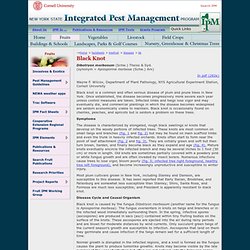
Theiss & Syd. (synonym = Apiosporina morbosa (Schw.) Arx) In pdf (282k) Wayne F. Black knot is a common and often serious disease of plum and prune trees in New York. Symptoms The disease is characterized by elongated, rough black swellings or knots that develop on the woody portions of infected trees. Most plum cultivars grown in New York, including Stanley and Damson, are susceptible to this disease.
Disease Cycle and Causal Organism Black knot is caused by the fungus Dibotryon morbosum (another name for the fungus is Apiosporina morbosa). Normal growth is disrupted in the infected regions, and a knot is formed as the fungus causes the plant to produce tumorlike growths. Ascospores are potentially available from the time of bud break until terminal shoot growth stops, but the greatest number appear to be released during the period between white bud and shuck split. Control. BlackKnot15.
Disease Control in Cherries, Plums, and Other Stone Fruits. A list of current publications from NDSU Extension Service. The materials on this site are organized by topic. Use the menu to browse for materials related to the listed topics. You'll find the most recent materials at the top of each list. The educational materials listed here have been through a thorough review process and are available in hard copy from the Distribution Center unless marked otherwise. Most are free in PDF format. Latest NDSU Extension Publications Safe Food for Babies and Children: Heating Solid Food Safely - FN715 Whether warming bottles or solid foods, it is ALWAYS important to use safe heating practices to keep your baby happy and healthy.
Grass Tetany - V1703 This publication provides clientele with overview of Grass Tetany, symptoms of the disorder, and management guidelines to prevent the disorder. Nourish Your Joints - FN1489 Most of us experience some joint stiffness during seasonal changes. Nourish Your Bones - FN1488 Size up the Supplement - FN1491. Black Knot. Black Knot (Dibotryon) Susceptible Plants to Black Knot: European Bird Cherry (Prunus padus); Chokecherry (Prunus virginiana) Less Susceptible Plants: Sour or Tart Cherries (Prunus sp.)
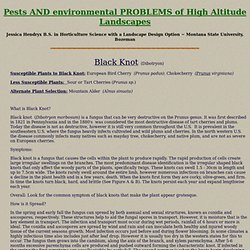
Alternate Plant Selection: Mountain Alder (Alnus sinuata) What is Black Knot? Black knot (Dibotryon morbosum) is a fungus that can be very destructive on the Prunus genus. Symptoms: Black knot is a fungus that causes the cells within the plant to produce rapidly. Overall: Look for the common symptom of black knots that make the plant appear grotesque. How is it Spread? In the spring and early fall the fungus can spread by both asexual and sexual structures, known as conidia and ascospores, respectively. Black knot, Apiosporina morbosa (Pleosporales: Venturiaceae) Black_knot_of_ornamental_plum_and_cherry_4-02-08r. Cherry Black Knot. Black Knot. I.
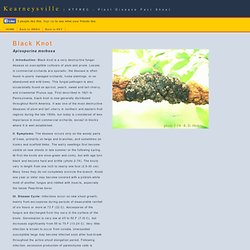
Introduction: Black knot is a very destructive fungal disease on susceptible cultivars of plum and prune. Losses in commercial orchards are sporadic; the disease is often found in poorly managed orchards, home plantings, or on abandoned and wild trees. This fungal pathogen is also occasionally found on apricot, peach, sweet and tart cherry, and ornamental Prunus spp. First described in 1821 in Pennsylvania, black knot is now generally distributed throughout North America. It was one of the most destructive diseases of plum and tart cherry in northern and eastern fruit regions during the late 1800s, but today is considered of less importance in most commercial orchards, except in blocks where it is well established.
II. III. IV. Continue to monitor for black knots (photo 2-74) during the bud-break to bloom period by examining ten vegetative terminal shoots on each sample tree. V. Chemical control - commercial growers Text prepared by K.D. Title. Chap32. Dibotryon morbosum. Dibotryon morbosum or Apiosporina morbosa is a plant pathogen, which is the causal agent of black knot.[1][2] It affects the cherry, plum, apricot and Shubert chokecherry trees of North America.
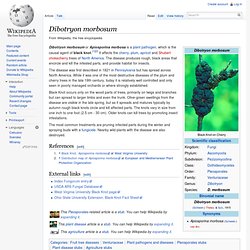
The disease produces rough, black areas that encircle and kill the infested parts, and provide habitat for insects. The disease was first described in 1821 in Pennsylvania but has spread across North America. While it was one of the most destructive diseases of the plum and cherry trees in the late 19th century, today it is relatively well controlled and only seen in poorly managed orchards or where strongly established. Black Knot occurs only on the wood parts of trees, primarily on twigs and branches but can spread to larger limbs and even the trunk. Olive-green swellings from the disease are visible in the late spring, but as it spreads and matures typically by autumn rough black knots circle and kill affected parts.
References[edit] External links[edit] FD04 - BLACK KNOT OF PLUM AND CHERRY. Black Knot of Plum and Cherry Fruit Disease Information Note 4 (FDIN 004) D.F.
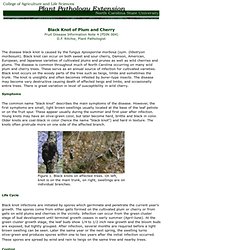
Ritchie, Plant Pathologist The disease black knot is caused by the fungus Apiosporina morbosa (sym. Dibotryon morbosum). Black knot can occur on both sweet and sour cherry, Damson, American, European, and Japanese varieties of cultivated plums and prunes as well as wild cherries and plums.